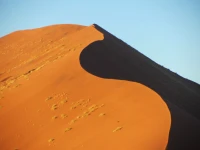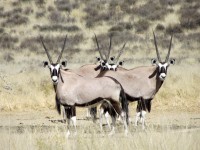Thirteen kilometres north-east of Keetmanshoop, on the farm Gariganus, is a huge Quiver Tree (Afrikaans name: Kokerboom) forest. This is not what one usually thinks of as a “forest”, but it is an amazing collection of approximately 250 Aloe dichotoma plants. These are tall (up to 7 meters or 23 feet tall), tree-like aloes which grow in the hot, arid regions of South Africa and Namibia. To find this many of them in one location is extraordinary. The reason it is known as a Quiver Tree is that bushmen have traditionally used the branches to make quivers (containers to carry their arrows).
We arrived there just after lunch in the hottest time of the day, but still stayed a while to walk around and take lots of photos. The forest was declared a Namibian national monument on June 1, 1995 – it is easy to see why.

The Namibian sky really is that blue! ©LB/notesfromafrica.wordpress.com

©WMB/notesfromafrica.wordpress.com

©WMB/notesfromafrica.wordpress.com

Close-up of a Quiver Tree showing the bark. ©LB/notesfromafrica.wordpress.com

©WMB/notesfromafrica.wordpress.com

The species name “dichotoma” refers to how the stems repeatedly branch into two (“dichotomous” branching) as the plant grows. [Wikipedia] [©WMB/notesfromafrica.wordpress.com

A “Dassie” or Rock Hyrax suns itself on a boulder. ©WMB/notesfromafrica.wordpress.com

This Dassie decided to use the hollow branch of a Quiver Tree to nest in. ©LB/notesfromafrica.wordpress.com
One can see from the rock photos below how the rock has been weathered along crack lines. The cracks probably forming as the rocks were heated by the sun and cooled at night; the wind and other elements doing the rest.

©LB/notesfromafrica.wordpress.com

©LB/notesfromafrica.wordpress.com
Close by on the same farm is what is known as The Giant’s Playground. It really looks like the some giant beings have used the local rocks piling them up like Lego blocks into columns and forming a maze. You can see from the size of the Quiver Trees in amongst the rock, just how high and big these rock piles are.
The dolorites at the quiver tree forest and giant’s playground form part of the bigger sill complex. The dolorites are magma that was pressed up, but cooled off just below the earth’s surface. The softer parts of the stone and the top layer of the earth’s crust eroded away, which left the dolorites exposed.
The dolorites are between 160 and 180 million year old, and in the Keetmanshoop region cover an area of 180 000 km2. – Quivertree Forest Rest Camp

Piles of rock as far as the eye can see. ©WMB/notesfromafrica.wordpress.com

©WMB/notesfromafrica.wordpress.com
This post is part of a series I will be publishing about our travels through Namibia. It is also part of my daily posts for October 2016 – otherwise known as The October Dash


















The trees remind me of the Joshua trees found in the American Southwest. Very similar structure.
I had a look at Joshua trees – they’re also very distinctive. Amazing to think that two very usual trees developed in similar environments on two separate continents.
How unusual and oddly attractive: landscape so different from any I have seen. Bark unlike any witnessed . . . [am thrilled to have been part of the ‘October Dash’ – have learned so much: major internet probs here so hope I’ll make it to the last two 🙂 ! Good’on’ya lady, if I don’t 🙂 !!!]
Parts of Namibia – especially in the south – look like moonscapes. The posts will still be here when you return.
How amazing that you and Willie went here – we also visited Gariganus during one of our drives back from Windhoek to Cape Town, many years ago. We stayed in one of their strange-looking igloos – and remember being grateful for the air-con as it was incredibly hot outside! Those quiver trees are simply extraordinary… and soo photogenic, at all times of the day.
We also explored the Giants’ Playground – and I still have vivid memories of wandering around in that maze, in the shimmering heat, with these huge columns of rocks piled ontop of each other. We were following the trail from one arrow to the next… and after a while realised that some naughty person must have changed one or two arrows around so they were pointing in a different direction… We were relieved to make it safely back to our car.
What is amazing about Namibia, is that you will be driving for ages with hardly any changes in scenery, and then you’ll come across something wonderful like this.
We didn’t attempt to find our way through the maze. It was just too hot to get lost.
Wonderful photos of a stunning place! What a magnificent species of plant – you have captured its features beautifully.
Thanks! The are very unusual plants so make a great photo subject.
Such unusual structures!! I have never seen anything like this, thanks for sharing 🙂
Yes, they are! Good subjects for photographers.